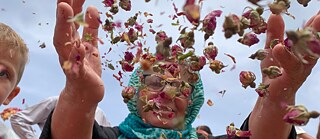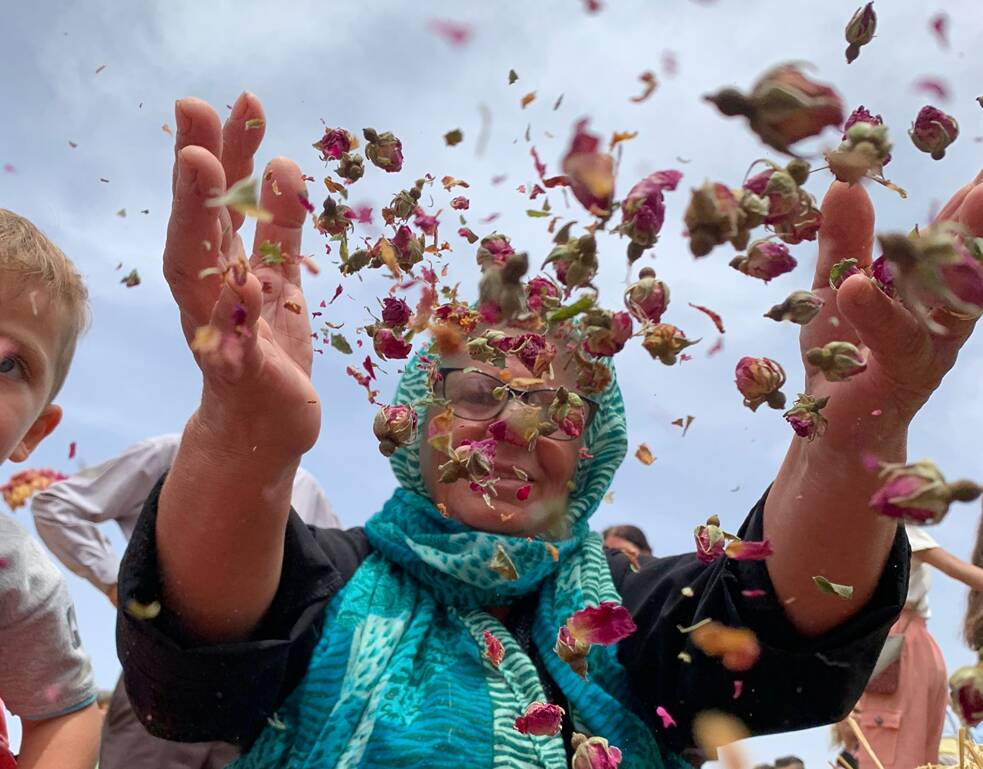The Damask rose, inscribed on the UNESCO Intangible Cultural Heritage list in 2019, flourishes in arid areas across the Syrian countryside, each contributing a unique local flavor to the rose’s products. When thousands of Damask roses blossomed prematurely, the farmers were put in a difficult position.
In the small, rustic Maarat al-Saleb, west of Hama, Syria, the rhythmic sound of racing breaths resonates loudly as farmers scurry to pluck hundreds of Damask rose buds from the village’s verdant fields—the harvest came earlier than expected.In the midst of the fray, lifelong friends and rose harvesters Farida Ahmed, 63, and Samra Khedr, 67, are stretching themselves to the limit, collecting as many buds as they can to salvage their livelihoods. Over 30 years ago, the two women could pick hundreds of roses without gasping for air, but as Khedr remarks, “age takes a toll.”
Climate change takes its toll
The rising temperatures have shifted the harvest season, which traditionally runs from May 15 to June 5, causing farmers to start a week early, and although Ahmed and Khedr have not formally studied climate change, they witnessed its impact firsthand. The earlier-than-expected harvest had caught them off guard.“From this beautiful rose, we extract five products we depend on for income: rose water, juice, jam, rose oil, and dried petals for herbal tea,” Khedr notes. “We’re working as hard as we can so we can pluck the buds before they bloom. I was depending on this year’s harvest to cover my son’s upcoming wedding expenses.”
According to several farmers from the community, the cost of a liter of Damask rose oil, which is best extracted before the flower blooms, exceeds USD 200. However, when thousands of Damask roses blossomed prematurely, the farmers were put in a difficult position that was exacerbated by the economic sanctions on Syria restricting the export of rose products, further limiting the farmers' reach.
“The impact of a seven-day shift could be devastating on local farmers,” explains agricultural engineer Bashar Horas. “Almost all of them rely on the rose’s products, especially its oil."
“Syria’s climate instability, marked by erratic rainfall and sudden heatwaves, puts further stress on the roses, making them susceptible to diseases like rose rust and powdery mildew.”
The Damask rose, inscribed on the UNESCO Intangible Cultural Heritage list in 2019, flourishes in Nayreb, Aleppo; Maarat al-Saleb, Hama; Marah, Damascus; Mahalba, Latakia; and other arid areas across the Syrian countryside, each contributing a unique local flavor to the rose’s products.
In Nayreb, along the southern outskirts of Aleppo, the yield of the 30 hectares of land cultivated has decreased by about one ton per hectare compared to previous years. According to the district’s agriculture director, Radwan Harsoon, this decline is due to climate-related issues and rising fertilizer costs.
Preserving heritage as a family
Love blossomed nearly 25 years ago between Asiya and Hassan Ibrahim in the fields of Damask roses. The couple met and exchanged glances while harvesting, and today, they carry on the tradition together as a family. They rely on the Damask rose crop and other produce grown by Hassan on land he inherited from his father.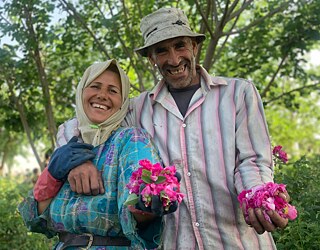
Asiya and Hassan Ibrahim tending to the harvest at Nayreb, Syria. | ©Safaa Sallal
“I treat the roses like my children and worry about them getting sick from the wind and summer heat. The Damask rose is delicate and only thrives in moderate weather,” she explains.
While walking through the fields, Hassan points out that this year's harvest season began a week earlier than usual due to rising temperatures, which accelerated the blooming of the highly sought-after rose buds.
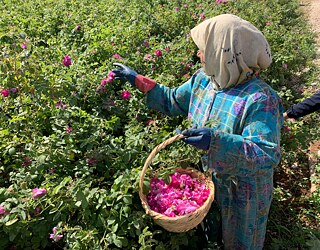
Asiya Ibrahim picking Damask rose buds at Nayreb, Syria. | ©Safaa Sallal
Director of agriculture for rural Damascus, Irfan Ziyada, explains that nearly 270 hectares were cultivated with Damask roses until 2011.
“Drought and years of war rendered vast agricultural lands unfit for cultivation. Now, only 120 hectares are currently planted with the rose,” he explains.
The Damask rose became heavily reliant on rainfall following the destruction of several irrigation facilities and water pumping stations across the Levant country in the wake of the war. Challenges such as the lack of access to water pumping stations and a decline in available labor have forced farmers to rely primarily on rainfall for agriculture
Searching for sustainable solutions
The current year's rainfall has averaged 125 mm, compared to approximately 140 mm in 2023 and 2022, whereas previous years recorded an average of 400 mm, as per a statement from Horas.In Marah, near Damascus, 5,500 residents heavily rely on rose farming. The ongoing drought accompanied by a decline in rainfall, has forced farmers to use well water.
A community-driven project supported by the Syrian government and the Syria Trust for Development dug a well providing 30 cubic meters of water per hour to address water scarcity.
“The trust was able to distribute seedlings to 85 farmers in Marah this year alone, and the well now irrigates 60 percent of the rose fields in the area,” Reem Ibrahim, supervisor of intangible heritage projects at the trust, says, adding that the organization also involves farmers in fairs and bazaars to showcase and sell their products.
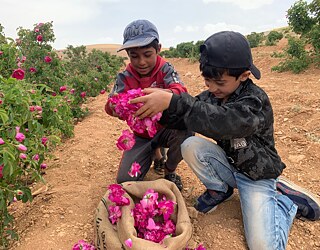
Children helping their families during the harvest time, Syria. | ©Safaa Sallal
Despite the war and sanctions, the trust remains dedicated to preserving the Damask rose, a commitment formalized in the preservation plan submitted to UNESCO when the rose was listed as intangible Syrian heritage in 2019.
The Syrian Ministry of Agriculture also plans to reclaim 300 hectares and plant 30,000 seedlings for free on farmers' lands, as per Ziayada.
Back in Maarat al-Saleb, the farmers have completed the day’s harvest. Ahmed and Khedr tally their yield, noting the impact of the season's challenges on their overall production, but the two women can be seen laughing and sharing stories, their spirits undimmed by the difficulties.
“Our friendship is intertwined with the harvest,” Farida notes, plucking one last bloom to add to her basket. “This rose is life for us. It has always been there. I am not worried.”
The article is published in collaboration with Egab.
September 2024
